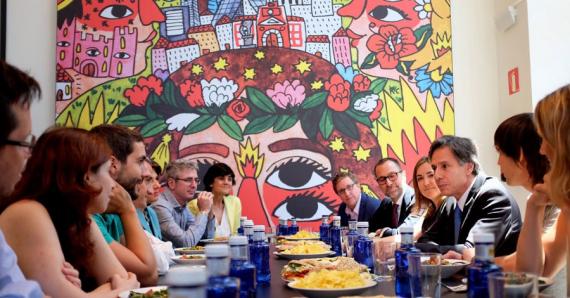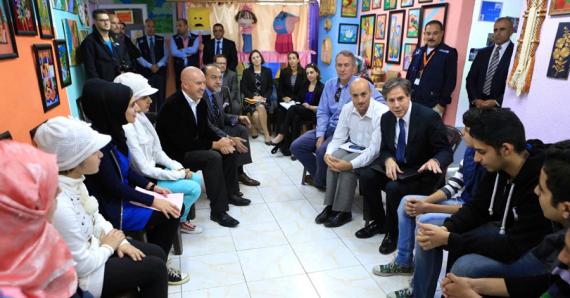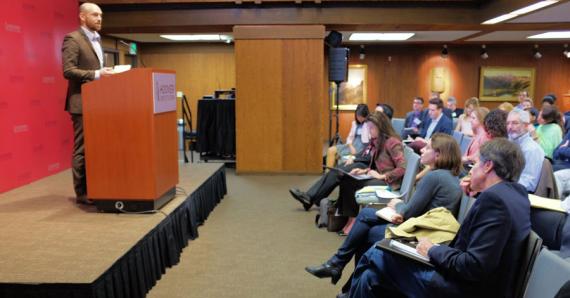By Deputy Secretary of State Antony “Tony” Blinken
Every day we work towards big goals — from building global food, health, and energy security to expanding access to education for refugees — that require the leadership and creativity of the innovation community.
And every day, we consider how transformations in science and technology will impact our foreign policy in the future. What does the revolution in robotics mean for warfighting, or advances in artificial intelligence for labor markets, or the advent of digital currencies for the dollar?

Deputy Secretary Blinken meeting with Spanish entrepreneurs at Google Campus in Madrid, Spain in August 2015. (photo courtesy of the State Department)
Across the State Department, we are intensifying our focus on building bridges with science, technology, and innovation communities so that efforts to make the world a little bit healthier, a little bit wealthier, a little bit safer, and a little bit wiser are empowered by the ingenuity and talent of the world’s problem-solvers.
Through a new initiative called the Innovation Forum, we are convening regular conversations between senior policymakers and global innovators to strengthen this connectivity — allowing innovators to inform foreign policy at the highest levels and foreign policy priorities to spark and accelerate new ideas. Through events, workshops, and roundtable discussions, the Innovation Forum enables the State Department to see more clearly around the innovation corner, while providing a window into what we are trying to achieve and inspiring others to join us.
We chose to focus the first event of the Innovation Forum on one of the most urgent challenges we face today — the danger of a lost generation of Syrian children.
For five years, the crisis in Syria has fallen most heavily on the smallest shoulders. Across the region, nearly three million Syrian children are not in class at all today. Their schools in Syria have been destroyed, occupied by armed forces, or turned into shelters. Many of their teachers have fled or been killed.

Deputy Secretary Blinken meets with refugees at UNICEF’s Makani Center in Amman, Jordan on Nov. 19, 2015. (photo courtesy of the State Department)
We know that the lack of education is one of the primary reasons families flee from Syria and then onward to Europe — risking their lives on the fierce seas or packing into sealed trucks of smugglers. Until we close the education gap, refugees will continue to travel farther and farther afield in pursuit of a hope shared by parents the world over: a better future for their children.
The United States — as the world’s leading humanitarian donor — has worked with heroic partners on the ground, including UN agencies and NGOs, to renovate classrooms, pay teachers, provide psychosocial care, and help schools manage double shifts. Since the start of the crisis, the United States has provided more than $5.1 billion in humanitarian aid, including food, shelter, and medical care for millions of Syrians.
But more must be done to reach every child with not only the promise of a more hopeful future but also a path to get there. We need game-changing new solutions and partnerships to provide language training, eliminate enrollment barriers, and deliver distance learning for children who are not able to regularly access school. And we need to ensure that these programs are accredited so children receive universal and transferable recognition for their education.
That is why we brought together over 100 humanitarians, coders, policymakers, designers, innovators, and educators at Stanford University to help significantly expand access to education for Syrian refugee children. Over the course of the day, participants dug into four different elements of the challenge and developed concrete new ideas, from an app for shared rides to school to a virtual training program to help teachers manage the unique challenges of educating children who have been exposed to trauma and violence. (You can read an insightful summary of the event from Brooking’s Sarah Dryden-Peterson.) The event only underscored the importance of harnessing the great reservoir of expertise and imagination that exists within our innovation community.

Deputy Secretary Blinken listen to presentations at the end of the workshop on refugee education technology at Stanford University in Jan. 2016. (photo courtesy of the State Department)
Ultimately, no single start-up, humanitarian organization, or country can close the education gap alone. Community leaders can help schools in their own neighborhoods connect with sister schools in the region. Corporate partners can deepen their investments in educating and training this next generation of talent. Education technology firms can work with humanitarian organizations on the ground to provide virtual learning platforms. In this time of unparalleled need, we all have a role and a responsibility to respond.
That’s why we don’t want to just have Innovation Forum discussions with those we can convene in a room. We want to open up these conversations to everyone who is grappling with these issues in unique contexts and with diverse perspectives.
I hope to use this channel to convey the insights and key questions that emerge from our discussions and invite innovators from around the world to add your voice — whether in the responses below, through guest articles on this channel, or in discussions we’ll launch on other online forums.
Sitting with a small group of refugee teenagers in Jordan, I reminded them of the story of a Syrian-American who went on to start a company named Apple that changed the world. Life has given these children a tougher path to fulfill their potential, but we know that given a chance — given an education — they can transform their futures and perhaps all of ours.
Editor’s Note: This blog entry originally appeared in the Department’s new Innovation Forum Publication on Medium.com.

